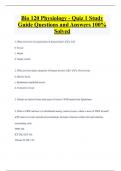Exam (elaborations)
NURS 6550 Midterm Exam – Question and Answers with Rationals – Walden University
- Course
- Institution
NURS 6550 Midterm Exam – Question and Answers with Rationals – Walden University 1. The AGACNP is caring for a patient who is quite ill and has developed, among other things, a large right sided pleural effusion. Thoracentesis is sent for pleural fluid analysis. While evaluating the fluid an...
[Show more]












